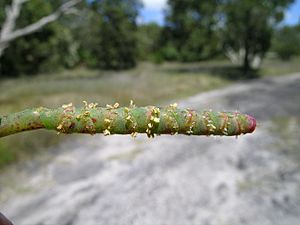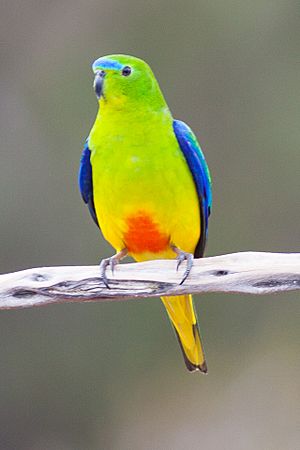Beaded samphire facts for kids
Quick facts for kids Glasswort |
|
|---|---|
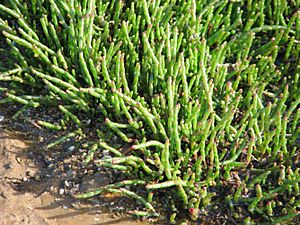 |
|
| Sarcocornia quinqueflora at Ricketts Point Marine Sanctuary | |
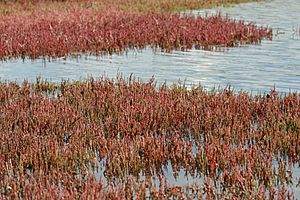 |
|
| at Sydney Olympic Park | |
| Scientific classification | |
| Kingdom: | |
| (unranked): | |
| (unranked): | |
| (unranked): | |
| Order: | |
| Family: | |
| Subfamily: |
Salicornioideae
|
| Genus: |
Sarcocornia
|
| Species: |
S. quinqueflora
|
| Binomial name | |
| Sarcocornia quinqueflora (Bunge ex Ung.-Sternb.) A.J.Scott
|
|
| Subspecies | |
|
|
Sarcocornia quinqueflora, often called glasswort or beaded samphire, is a special plant. It's a type of succulent shrub that loves salty places. You can find it growing in wet coastal areas. It lives in Australia and New Zealand.
Long ago, people would burn glasswort. They collected the ashes, which had a lot of soda. This soda was used to make soap and glass. That's probably how the plant got its name, "glasswort."
Contents
What is Glasswort?
Glasswort, or Sarcocornia quinqueflora, is a plant that can handle salt. It grows as a small shrub and lives for many years. Plants that live for many years are called perennials. You usually find them near salty water, like along the coast. They often grow flat on the ground, forming a mat.
How Glasswort Looks
The stems of young glasswort plants are soft and fleshy. They can be grey, green, or even reddish at the tips. As they get older, the stems become dry and woody. The leaves grow in pairs, one opposite the other. They are connected at their base.
The leaves look like tiny blades wrapped around the stem. This makes the stems look like they have "beads." At the end of the stems, you'll find the flowers. These flower clusters are spiky. They have small segments with tiny groups of flowers. Each group usually has three flowers.
The flowers can be male, female, or both. They are almost always the same size. They have parts that produce pollen (stamens) and parts that hold the seeds (ovaries). The seeds are round, light brown, and hairy.
Where Glasswort Lives
Around the World
Glasswort is not only found in New Zealand. It grows in many places around the world. In New Zealand, it's mostly found along the shoreline. You can see it in the North Island and on the east coast of the South Island. In Australia, it grows in the southwest, southeast, and even in parts of the Nullarbor Plain.
In New Zealand
In New Zealand, glasswort is common in coastal areas. It grows on all the main islands, including Stewart Island and the Chatham Islands. It's found on both coasts of the North Island. It also grows down the east coast of the South Island. Interestingly, it's even found in Central Otago, far from the sea.
How Glasswort Reproduces
Glassworts are perennials, meaning they can reproduce many times. They don't always need to make new seeds. They often make exact copies of themselves. This is called clonal propagation. It helps them spread quickly. When conditions are good, they also make new plants from seeds. This keeps the population healthy and diverse.
Young plants often stay connected to the parent plant. This helps them survive until they are strong enough on their own. Seeds usually start to grow in early spring when it gets warmer.
Glasswort Flowers
Glasswort plants can have different types of flowers. Some populations have plants with both male and female parts (hermaphrodites). Other populations have both female plants and hermaphrodite plants. Most glasswort plants are hermaphrodites.
In hermaphrodite flowers, the female part matures before the male part. This stops the plant from fertilizing itself. The female part appears a few days before the male part. The male part then releases pollen. Wind usually carries this pollen. Glasswort flowers don't make nectar, so insects don't usually pollinate them. However, honeybees have been seen visiting the flowers.
Dangers to Glasswort
New Plants Taking Over
When new plant species are brought into an area, they can harm glasswort. These new plants often grow faster than native glasswort. They can take over the glasswort's habitat. For example, in Australia, an invasive grass called Cordgrass has changed coastal areas. It turned mudflats into marshlands. This left glasswort without its natural home.
Glasswort Gall Mite
A tiny mite called Aceria rubifaciens feeds only on glasswort. When it feeds, it creates small bumps or "galls" on the young stems. The mites live inside these galls. The galls protect them from predators and bad weather. This mite has mostly been found in the North Island of New Zealand.
Other Threats
Glasswort is also edible. This means both animals and humans can eat it. So, animals and humans can also be seen as "predators" of glasswort.
Interesting Facts About Glasswort
Inland Habitat
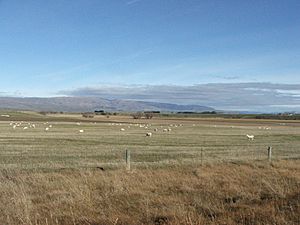
Glasswort has been found growing far from the coast in Central Otago, New Zealand. This is unusual because it loves salty soils near the sea. The Maniototo Plain has very salty soil. This is because the area is very dry. As rocks break down, salt builds up in the soil. Not enough rain falls to wash the salt away. This makes the soil salty enough for glasswort to grow. Birds likely carried the seeds to this inland area.
Food for Parrots
The Orange-bellied Parrot is a critically endangered bird from Australia. There are only about 180 of these parrots left in the wild. This bird mainly eats the seeds of glasswort. As glasswort habitats disappear due to human activity, it's harder for the parrots to find enough food. This makes it even tougher for them to survive.
Glasswort in Recipes
Glasswort is not just a tough plant; it's also edible! People recommend eating the fresh, young, upper parts of the stems. They are tender and have a good flavor. You can eat glasswort raw in a salad. It also makes a great garnish with seafood. Because it's naturally salty, it can add flavor to soups or stews. You can also serve it as a cooked vegetable. Some people even pickle the fresh stems.
A different type of glasswort grows in America. Native Americans use the seeds of that plant to make flour.
Glasswort may also have some health benefits. It's high in Vitamin C, Vitamin A, and B-complex vitamins. Some people say it helps with digestion. Certain natural compounds in glasswort are also being studied for possible health uses.
See also
 In Spanish: Sarcocornia quinqueflora para niños
In Spanish: Sarcocornia quinqueflora para niños


